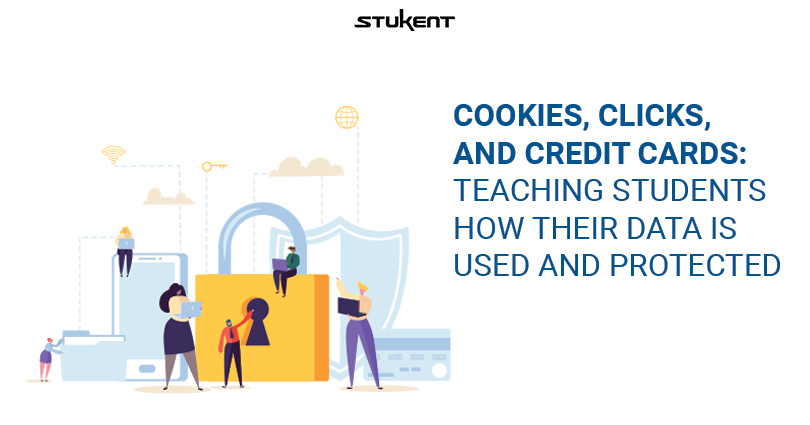Adapted from Debika Sihi’s Presentation at the Summer Stukent Digital Summit 2020
How is data gathered, used and protected, and why is this important when teaching a digital marketing course? The topics of privacy and regulatory environment cut across all facets of digital marketing. Whether it’s an advertising campaign or a social media campaign, the common thread is the focus on data-driven approaches.
As a business and digital marketing professor at Southwestern University, I’ve created three lessons that not only educate students on how they’re truly sharing personal data, but also provide insight into their roles and responsibilities as both consumers and future marketers. This post supplies readings, resources, tools, and discussion ideas for you to incorporate into your course. With this material, alongside the “Digital Marketing Essentials” textbook, students can contextualize the environment in which marketers operate as they delve into thought-provoking privacy paradoxes and a regulated environment.

Lesson 1: Privacy Paradox
Digital marketing students are already acclimated to creating campaigns tailored for a specific audience. With that in mind, this first lesson lends itself to thinking about consumer concerns surrounding those personalization aspects of targeted campaigns.
Step 1: Leverage the Web Annotation Tool
Hypothes.is is a free web annotation tool. After creating a free account, you can start a group to then send to your students. This tool allows you to go to any website or journal article and make web annotations, which is an important component for this lesson. Students are instructed to make at least one annotation in each assigned article before class in order to generate questions and initiate discussion topics. As a professor, this tool also helps to see what students are interested in talking about before the in-class discussions.
Step 2: Utilize Online Articles
“Personalization Versus Privacy: Making Sense of the Privacy Paradox”
This shorter reading from HubSpot goes through the consumer behavior aspects of privacy versus personalization. The idea is that consumers want privacy but they’re worried about how their data is used. However, at the same time, at every encounter we see people showing a willingness to give away their data.
“The Personalization-And-Privacy Paradox”
Although a little heavier on the data side, this Ad Age article is still very digestible and a great read for establishing a discussion on data or marketing analytics. The reading focuses on third-party and zero-party data and the idea that everything you get is a customer opt-in.
“Google Wins Landmark Right to Be Forgotten Case”
This article published by the BBC goes into the history about the right to be forgotten. The reading centers on the idea of Google’s right to be forgotten. In the European Union, someone can petition Google to remove information about them that is outdated, untrue, no longer valid, or something they perceive as slanderous. Google had apprehension about this because they see themselves more as a disseminator of information, rather than a creator. This article digs deeper into the role of search engines and the debate on keeping data as is, or the option to restrict and remove search engine data.
“The Solace of Oblivion”
This longer read from The New Yorker starts with a pretty tragic story where a young woman gets in a car accident. Photos from the accident were disseminated on the Internet and her family struggles to have the images removed. This story leads into the topic of the privacy versus free speech struggle. It provides historical context for why the regulatory movement started in the European Union versus the United States. It’s an article that gets students interested and feeling very passionate about the subject of privacy versus free speech.
Step 3: In-Class Discussion/Activity
This in-class discussion is structured as an activity. To take personal views out of it, students are assigned a role. Following the readings in Step 2, have students objectively talk through the advantages and disadvantages of collecting consumer data based on their roles. Discuss provisions that one can take to protect consumers.
Assign students one of these roles:
- Individual consumer
- Marketer in an organization using digital advertising (therefore collects consumer data)
- Executive at Google thinking about how to handle the right to be forgotten
Possible discussion questions include:
- What are the differences and explanations in the policy for the United States versus Europe?
- What is the role of a search engine?
- Do search engines make information accessible or do you consider them a creator of information?
- Google has over 90 percent of search engine volume, so is their role slightly different?
Lesson 2: Personal Data
Setting up the context for this lesson, have students think about the role of the search engine. Ask them to think about the role of the marketing agency, and think about their role as the consumer. What does the data privacy context look like? In this lesson, we start to focus on what personal information exists online. Utilizing Facebook, you can have your students download the data of their activity log (i.e. different information that Facebook is collecting on the user’s account.) Google does the same thing with search history and is easily accessible.
Activity 1: Analyze Personal Data
Instruct students to bring their laptops to class, or they can complete this activity on their phones. Have students analyze their data. Students can choose to download their Facebook data or their Google data. Allot time for students to read through the instructions on how to download data from either Facebook or Google and to analyze their information.
- Click here to provide information on how to download Facebook Data.
- Click here to provide information on how to download Google Data.
Once students have downloaded and become familiar with their data, allot time for a class discussion. What did they find? Was there any data that they were surprised was collected? Have the class discuss their findings and insight.
Activity 2: Analyze Privacy Notice
Once students look at their data, find a privacy notice to have students analyze. Here is Amazon’s privacy notice as an example. Take 10 minutes to discuss class findings and insight. What did they find confusing? Have they checked privacy notices before? The discussion can draw on some of the concepts from the Stukent Digital Marketing Essentials textbook. This activity leads into the regulatory environment because there is much debate about privacy statements being digestible for the everyday consumer versus companies providing fully-detailed legalese in order to protect themselves.
Lesson 3: Regulatory Environment Discussion
Instruct students to read through the two articles and watch the video. Then, divide students into groups to discuss for 10 to 15 minutes. Have students share their group’s insight with the class. This can also be completed as a small in-class presentation.
“Privacy Challenges and Opportunities: The Role of the Federal Trade Commission”
This article was written by the director of the Federal Trade Commission at the time. It gives a really good overview, even for the instructor, on how the FTC regulates privacy and what companies collect in the United States. They talk about the Notice and Choice model, which is really what we follow in the United States.
“GET READY FOR THE CALIFORNIA CONSUMER PRIVACY ACT (CCPA)”
The California Consumer Privacy Act is something that went into effect this year. It is the most sweeping state legislation. California tends to be very consumer focused as a state. It targets larger businesses with an annual revenue of $25 million or more, at least 50,000 consumers, and 50 percent or more of their revenue coming from data brokerage services. Larger organizations are collecting a lot of consumer data even though California is the first state to enforce it. This went into effect in 2020 and 17 other states are pursuing a similar type of legislation. People are now talking about no matter the election outcome, that a bipartisan bill that would support a national privacy reform.
“Everything You Need to Know About a New EU Data Law That Could Shake Up Big US Tech”
This CNBC video gives great information on the overview of GDPR. GDPR is complicated in Europe and it came out in 2018. Students find it fascinating because they don’t understand why something in the European Union would impact companies here.
Meet Debika Sihi
Debika Sihi is an associate professor of business at Southwestern University. Her research explores the impact of technological innovations on marketing strategy. She has published works in peer reviewed marketing and business journals and serves on the Editorial Board of Marketing Education Review. Sihi also teaches a variety of business courses including digital and strategic marketing.
Fall Stukent Digital Summit
For more information and presentation material to leverage in your classroom, register here for the upcoming Stukent Digital Summit. The virtual conference will take place on Friday, Nov. 6, 2020 at 8 a.m. MDT. The Stukent Digital Summit is put on three times a year, where higher education instructors come together to gain insight from professors and other industry professionals alike.






